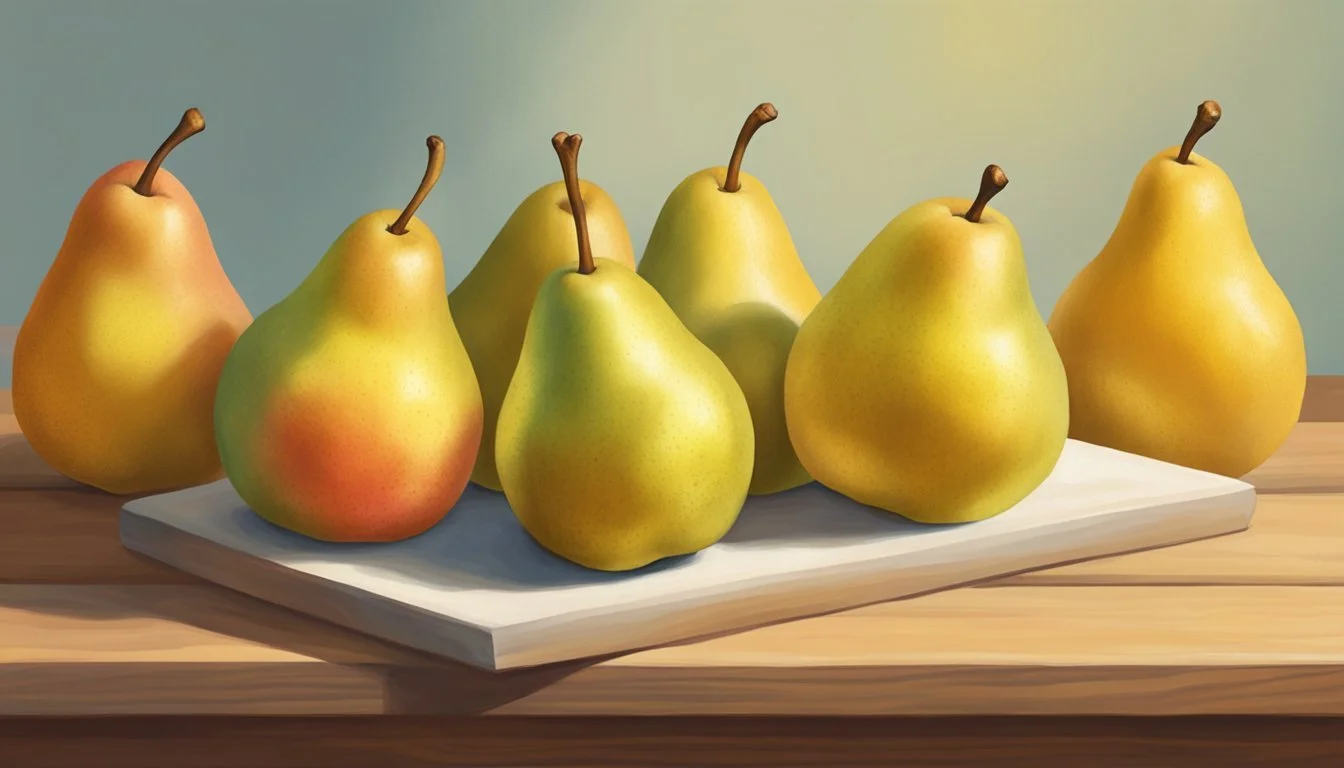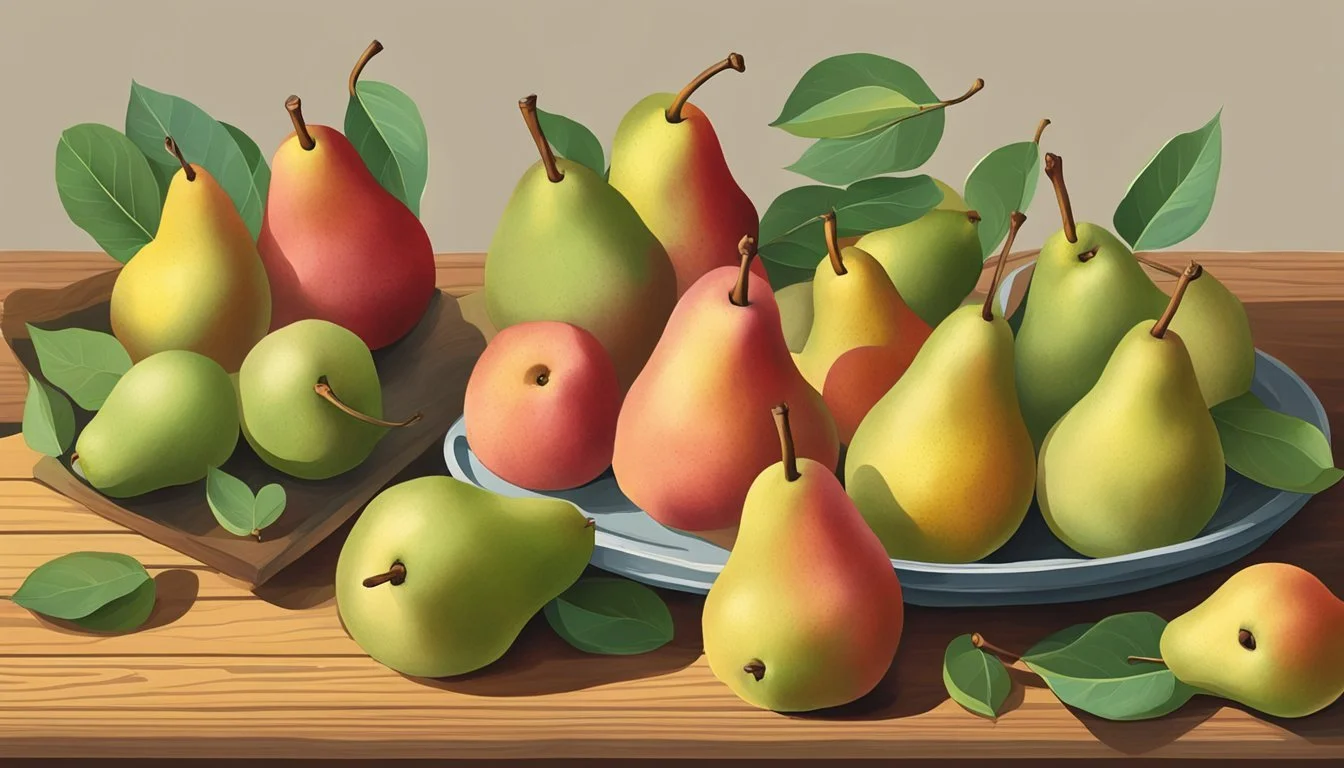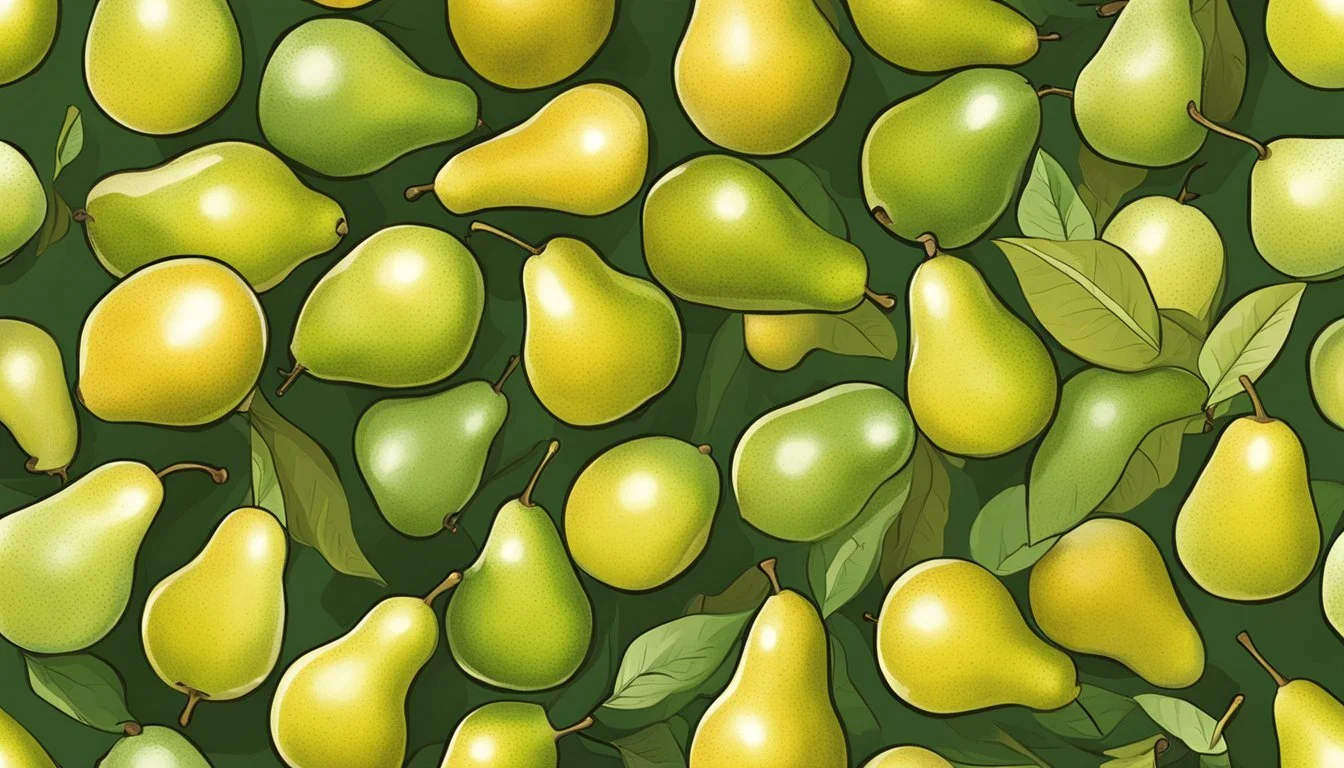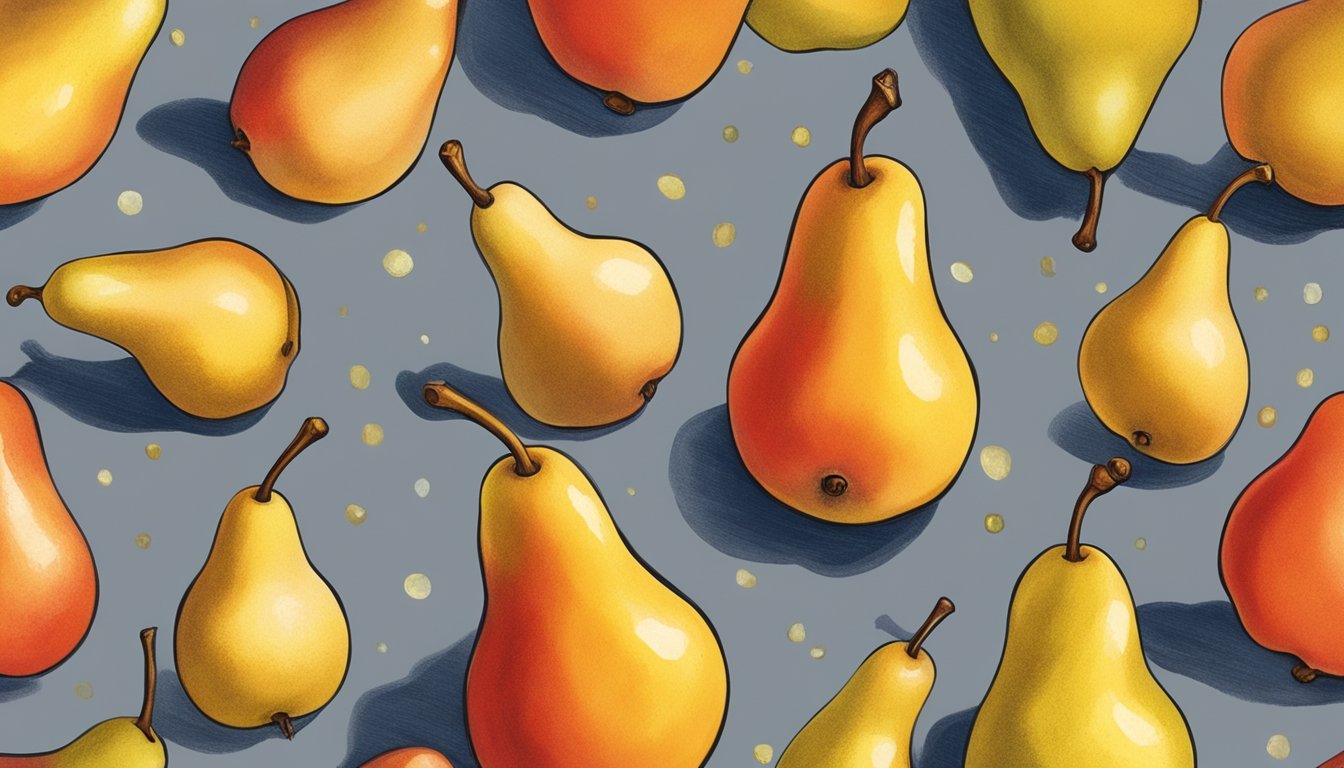How to Tell If Forelle Pairs Are Ripe
Selecting the Sweetest Fruit
Determining the ripeness of Forelle pears is an essential skill for those who enjoy the sweet and subtly tangy flavor of this unique fruit. Forelle pears are distinguished by their petite size and distinctive red freckles, known as lenticels, that speckle their yellow skin. Unlike some fruit that may exhibit obvious signs of ripeness, pears ripen from the inside out, making it crucial to assess them carefully to ensure the best eating experience.
One reliable method to judge the ripeness of a Forelle pear is to check its color. A ripe Forelle pear will usually have a golden-yellow hue, but the true indicator lies in the firmness of the pear around the stem. By gently pressing the neck, or the area around the stem, one can feel for a slight give, which suggests that the pear is ripe and ready for consumption. The aroma is another clue; a ripe Forelle pear will emit a sweet fragrance.
Key Takeaways
Forelle pears can be identified by their size and red lenticels.
Ripeness is best assessed by checking the give around the pear’s stem and color change to golden-yellow.
A ripe Forelle pear emits a sweet aroma, indicating it's ready to be enjoyed.
What Makes Forelle Pears Unique
Forelle pears are renowned for their distinctive size and appearance that set them apart from other pear varieties. These pears exhibit a unique color-changing characteristic as they ripen, and their history is as rich as their flavor.
Origin and History
The Forelle pear's journey began in Germany, originating from the region of Northern Saxony. It is an old variety that has been cherished since the 1600s. They were later introduced to America by German immigrants, and they have since become a beloved pear variety in many parts of the world.
Characteristics of Forelle Pears
Size and Shape: Forelles are one of the smallest varieties of pears, typically a little larger than Seckel pears. They possess a symmetrical, bell-shaped body, starting with a rounded base and tapering evenly to a short neck.
Color and Skin: One of the Forelle pear's most striking features is its skin color, which transforms as it matures. The skin color changes from green to a bright yellow when ripe, accentuating the trademark red lenticels—the red freckling on its skin. This color conversion is a tell-tale sign of ripeness.
Skin Attribute: Original Color
Description: Green, suggesting immaturity
Skin Attribute: Ripened Color
Description: Golden-yellow with visible red lenticels
Skin Attribute: Texture
Description: Smooth, with a freckled appearance
In addition to their vibrant colors, Forelle pears are valued for their crisp texture and sweet flavor. They remain colorful and eye-catching throughout the ripening process, which helps distinguish them from other pear varieties both on the tree and in the fruit bowl.
Assessing Ripeness of Forelle Pears
When assessing the ripeness of Forelle pears, one must consider visual cues, texture and firmness, and the aroma. These indicators provide a comprehensive understanding of the pear's maturity stage.
Visual Indicators
Forelle pears signal their ripeness through a change in skin color. As they ripen, their skin shifts from green to a golden-yellow hue. Additionally, these pears are known for their red lenticels, which are more pronounced and visible when the pear is mature. Observing these features closely can determine if the fruit has reached its peak ripeness.
Color Transition: Look for a transition from green to a golden-yellow tone.
Red Lenticels: Notice if the distinctive red spots, or lenticels, are clear and pronounced.
Texture and Firmness
The texture of a ripe Forelle pear should yield slightly to gentle pressure. A key area to check is the neck; if it's firm, the pear still needs time to mature. Conversely, if the pear feels very soft, especially around the stem, it may be overripe.
Check the Neck: Apply gentle pressure to the neck area; slight softness indicates ripeness.
Overall Firmness: The body should be on the cusp between firm and soft.
Aroma Test
Ripe Forelle pears emit a sweet and fragrant aroma. By taking a sniff at the base of the stem, one should be able to detect this distinctive smell. A ripe pear’s aroma will be noticeably sweet. The absence of a fragrant aroma generally means that the pear is not yet at optimum ripeness.
Sweet Smell: Inhale near the stem for a sweet aroma indicating ripeness.
Fragrant Aroma: A fully ripe Forelle pear will be fragrant, hinting at its sweet flavor profile.
Storing and Handling Forelle Pears
Proper storage and handling are essential for maintaining the quality of Forelle pears after harvest. The ripening process can be managed at room temperature, while refrigeration is pivotal in prolonging the pear's shelf life once it has reached the desired ripeness.
At Room Temperature
To ripen Forelle pears, one should keep them at room temperature. Pears produce and respond to ethylene gas, a natural compound that promotes ripening. Placing pears in a paper bag can concentrate the ethylene and expedite ripening. It's critical to check the pears daily, as they can quickly transition from ripe to overripe. One should avoid exposing them to excessive heat or direct sunlight, as this can lead to uneven ripening and increased chances of bruising.
In the Refrigerator
Once Forelle pears have ripened to one's preference, refrigerating them slows down ripening and preserves their freshness. The pears should be stored in the crisper drawer of the refrigerator at approximately 30 degrees Fahrenheit, ideally with 85 to 90% humidity to prevent dehydration and bruising. It's advisable to store pears away from strong-smelling foods, as they can absorb odors. Typically, ripened Forelle pears can be stored in the refrigerator for a few days to a couple of weeks, depending on their initial ripeness when placed in the fridge.
Enhancing the Ripening of Forelle Pears
To ripen Forelle pears to perfection, understanding the role of ethylene gas is essential. Equally important is knowing how companion fruits can facilitate the ripening process.
Ethylene Gas and Its Role
Ethylene gas is a natural plant hormone that plays a pivotal role in the ripening process of fruits. Forelle pears produce ethylene as they mature, and exposing them to additional ethylene can encourage them to ripen faster. One can expedite the maturation of pears by placing them in a closed environment, such as a paper bag, where the concentration of ethylene gas increases, stimulating the ripening process.
Companion Fruits for Ripening
Certain fruits, like apples, bananas, and avocados, are known ethylene producers and can be used to speed up the ripening of Forelle pears. Placing Forelle pears in a bowl or paper bag with one of these companion fruits can help the pears ripen more quickly. Here's how to use companion fruits effectively:
Apples: An apple can be placed with Forelle pears to encourage faster ripening. The ethylene gas released by the apple speeds up the process.
Bananas: Because bananas release a significant amount of ethylene, they are among the most effective fruits for ripening pears.
Avocados: These can be used as a companion fruit, but they typically release less ethylene compared to apples and bananas.
A table summarizing companion fruit and relative ethylene production:
Companion Fruit: Apple
Ethylene Production Level: High
Companion Fruit: Banana
Ethylene Production Level: Very High
Companion Fruit: Avocado
Ethylene Production Level: Moderate
Store the pears and companion fruits at room temperature and check daily for ripeness.
Uses of Forelle Pears in Culinary
Forelle pears are prized for their sweet and tangy flavor, making them versatile in culinary applications. They can be eaten fresh, incorporated into a variety of dishes, and even preserved for long-term use.
Snacking and Salads
Forelle pears, when ripe, offer a sweet and slightly tangy flavor that is ideal for eating out of hand. Their firm texture also makes them a favorable choice for adding a crisp contrast to salads. To determine ripeness for snacking or salads, look for a golden-yellow color and a sweet aroma.
Snacking: Eat ripe Forelle pears alone for a sweet treat.
Salads: Dice or slice ripe Forelle pears and mix them into green or fruit salads for added sweetness and texture.
Cooking and Baking
Forelle pears maintain their shape well during cooking and baking, which enhances their utility in both sweet and savory dishes. When slightly underripe, their firmness and subtle sweetness are perfect for cooking, while ripe to overripe pears are better suited for baking.
Cooking:
Sauté with vegetables for a sweet addition.
Add to roasts or stews for a unique flavor combination.
Baking:
Perfect for tarts, pies, and pastries, as their texture withstands the baking process.
Overripe Forelle pears can be pureed for use in baked goods.
Note on Bruising: Forelle pears can bruise easily when overripe, so handle with care during preparation for cooking or baking.
Selecting and Buying Tips
When shopping for Forelle pears, consumers should focus on identifying the hallmarks of ripeness and be cognizant of the seasonal nature of their availability to ensure they bring home fruit that's at its peak for consumption.
Choosing the Perfect Ripeness at the Store
To select a ripe Forelle pear, one should look for fruit with a golden-yellow skin, a hint that it has matured sufficiently. In supermarkets, this may vary as some pears are picked before peak ripeness to withstand shipping. Gently press near the stem; a slight yield indicates ripeness, while hard fruit needs time to ripen. Overripe pears often have soft or mushy spots, so one should avoid those.
Understanding Seasonal Availability
Forelle pears, like many fruits, have a seasonal availability, typically harvested in Oregon and Washington from late fall through winter. This is when shoppers can expect to find the freshest and most flavorful pears. Off-season, the pears found in supermarkets may have been stored and could differ slightly in taste and texture from those consumed at the time of harvest.
Forelle Pears and Health Benefits
Forelle pears are a nutritious fruit that offer a variety of health benefits. They are recognized for their small size, bell-shaped symmetry, and distinctive red lenticels. As a member of the pear family, they share similar nutritional values with other pear varieties, providing essential vitamins, minerals, and dietary fiber.
Nutritional Content of Forelle Pears:
Vitamins: High in Vitamin C, which is important for immune system health and skin repair.
Fiber: A good source of dietary fiber, promoting healthy digestion and reducing the risk of chronic diseases.
Minerals: Contains minerals such as potassium and copper, aiding in cardiovascular and neurological health.
Health Benefits Attributed to Forelle Pears:
Digestive Health: The fiber content in Forelle pears helps in maintaining a healthy digestive system.
Weight Management: Being low in calories yet high in fiber makes these pears an ideal choice for those looking to manage their weight.
Antioxidant Properties: Forelle pears contain antioxidants that contribute to reducing the risk of various diseases by combating free radicals.
Heart Health: Regular consumption of pears may be linked to lower blood pressure and reduced risk of stroke.
It is important to note that while Forelle pears offer these health benefits, they should be included as part of a balanced diet. Individuals should consume a variety of fruits to ensure a wide intake of nutrients.







